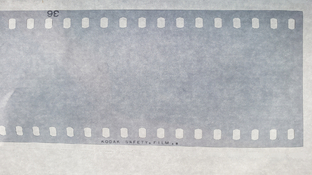The development of the BH Perforation and its full acceptance for use date back to the 1910 time-frame. Initially, a circular perforation was developed (I think by users in Europe), and the BH perforation or its early variant, (I think developed and used by Edison's team), simply modifed the circular hole. In that time-frame, Kodak was not perforating film...simply selling slit rolls where customers could perforate the film in the format their equipment would use. The BH perforation was finalized by Bell & Howell, the original manufacturer of reciprocating perforators, by taking the circular perforation and reducing it by adding two flats to it.
Once the Society of Motion Picture Engineers was formed and developed a formal standard for perforation placement, design, and dimensions, Kodak began purchasing equipment to perforate film. That happened in the 1916 time-frame. All equipment back them utilized the BH perforation. The equipment in cameras to advance the film and fix the position utilized the shape of the BH perforation to lock-in positioning for improvements in steadiness through the entire process.
The KS perforation, developed by Kodak and approved by SMPE (now SMPTE), was implemented for distribution type films because repetetive use of the BH perforation in conveying projected prints was leading to film fracture from the angled points of the BH perforation - the place of greatest stress concentration. The KS hole reduced the damage and allowed theaters to show prints longer without fear of the film breaking due to the tearing at the perforations.
There were questions as to why the BH perforation remained in use for camera negative and lab films. SMPE would have had to approve such a change and that never occurred, although some of the documentation I saw when I worked inside Eastman Business Park did indicate that Kodak did propose that a long, long time ago.
When 35mm consumer and professional film began, the KS hole was used for this format because the cost to manufacture the punches and dies was much less than that for the BH hole. The same is true for the 65mm / 70mm films which came in after the KS hole and all films are made with the KS hole.
CMACD123 mentioned a "Duvray Howell" perforation. The name is Dubray-Howell, and was a perforation which was implemented for full-fitting precision step optical printers, where film "stacks" were being printed onto an intermediate. (Think of "Star Wars" spaceship battle scenes where upwards of 16 pieces of original camera negative were "stacked" onto intermediates to create the scene with lazer blasts, explosions, and many spacecraft models. All that is now created in digital space so the need for the DH film ended, though as of a few months ago, tooling was still available in the factory.
Now, the original roll shown with BH perfs and a totally blank "Kodak Yellow" cassette sounds like this roll was some sort of test film cassette. I remember in the mid-1980's, we utilized blank metals for test cassettes when new films were sent for testing. I may still have one of the Kodachrome 200 in my collection. We did manufacture some products with a BH perforation back in the late 1980's, but I no longer have access to those formal prduct lists and information, as I have now left that wonderful factory.











